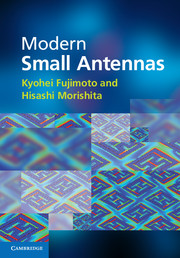Book contents
- Frontmatter
- Contents
- Preface
- Acknowledgements
- 1 Introduction
- 2 Small antennas
- 3 Properties of small antennas
- 4 Fundamental limitations of small antennas
- 5 Subjects related with small antennas
- 6 Principles and techniques for making antennas small
- 7 Design and practice of small antennas I
- 8 Design and practice of small antennas II
- 9 Evaluation of small antenna performance
- 10 Electromagnetic simulation
- 11 Glossary
- Index
- References
9 - Evaluation of small antenna performance
Published online by Cambridge University Press: 05 January 2014
- Frontmatter
- Contents
- Preface
- Acknowledgements
- 1 Introduction
- 2 Small antennas
- 3 Properties of small antennas
- 4 Fundamental limitations of small antennas
- 5 Subjects related with small antennas
- 6 Principles and techniques for making antennas small
- 7 Design and practice of small antennas I
- 8 Design and practice of small antennas II
- 9 Evaluation of small antenna performance
- 10 Electromagnetic simulation
- 11 Glossary
- Index
- References
Summary
General
Generally, evaluation of small antenna performance tends to be difficult, as the size of an antenna becomes very small. The difficulty of small-antenna measurement originates in small dimensions, asymmetry of antenna structure, and the antenna characteristics sensitive to the influence of its environment. Determination of correct or precise antenna performance will become difficult as the antenna dimension becomes smaller. Evaluation of antenna performance is performed by means of EM simulation and measurement. In this chapter, measurement of small antenna performances is described, whereas simulation is dealt with in Chapter 10. There are no essential differences between small antenna measurement and ordinary antenna measurement. However, as the size of an antenna becomes smaller, special considerations are required in order to assure the reliable evaluation of small antenna performances. Typical attentions are paid for cases:
(1) When the size of an antenna is very small compared with its wavelength or the size of a nearby conductor.
(2) When antenna structure is asymmetric and complicated.
(3) When an antenna is located in a complicated environment.
Although particular considerations are given to the measurement of small antennas, there may be some cases where no effective method is found for the accurate determination of the antenna characteristics. For example, when the size of the antenna is extremely small, the resistance becomes too small to be determined. Another case is where the antenna structure is so complicated that precise measurement is very difficult to perform.
- Type
- Chapter
- Information
- Modern Small Antennas , pp. 371 - 388Publisher: Cambridge University PressPrint publication year: 2014



